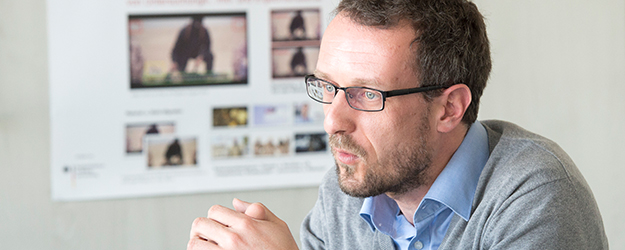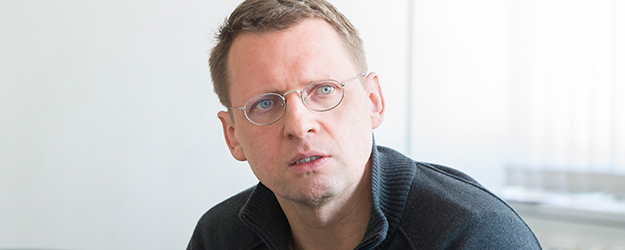25 May 2018
The Jihadism on the Internet interdisciplinary junior research group started last year. The researchers analyze online radical Islamist propaganda and track down all individuals that respond in any way to this kind of material. The group is also preparing a unique online platform. The project at the Department of Anthropology and African Studies at Johannes Gutenberg University Mainz receives funding from the German Federal Ministry of Education and Research (BMBF) to the tune of EUR 2.7 million.
Jihadist propaganda has many different forms: There is a rapper shown romping in the snow with young IS recruits somewhere in Syria and merrily calling for others to join in. Another documentary deals with a young man suffering from social injustice in Germany – and presents his conversion to Islam and his joining the struggle for the Islamist cause as a way out of his problems. Next to rousing sermons there are disturbing videos of executions that make the headlines. There are also elaborate online journals, crude video messages and the like.
Extreme Islamist groups have long used the Internet to self-promote and recruit and to spread their jihadist propaganda. However, academic analysis of this phenomenon is still very much in its infancy. Much is still unclear: Who is putting these messages online? How much cinematic skill goes into these productions? And what sort of impact do they have on their viewers? These questions are being investigated by the Jihadism on the Internet junior research group, which was formed last year at the JGU Department of Anthropology and African Studies.
EUR 2.7 million from the German Federal government
"When we started the project, we received support through inner-university research funding and from the Center for Intercultural Studies at JGU," explains Professor Matthias Krings, who established the research group. This put the initial groundwork in place. The project really took off when the German Federal Ministry of Education and Research (BMBF) launched its Research for Civil Security program. "Over the next five years, our work will be funded with EUR 2.7 million," says Krings.
There is a large screen on the wall of the seminar room where the junior research group meets. "This is where we watch the videos and discuss them," project manager Dr. Christoph Günther explains. A group of six researchers scrutinize the materials. Each one brings their own expertise to the table. "We have an interdisciplinary approach, which is important. Our team includes two specialists in Islamic Studies, two in Anthropology, and two in Film and Media Studies." Günther himself is an expert in Islamic Studies. He is supported by doctoral candidate Alexandra Dick. The two other specialist groups have a similar structure.
"This means we see and hear so much more than would be possible for an individual working alone. My help is sought out to interpret specific passages of text, for example. Both our anthropologists try to understand the material and concepts shown from the film-maker's perspective while media studies specialists analyze the cinematic production techniques."
Hollywood-style trailers
Dr. Bernd Zywietz is one of these media studies specialists. For many years now his main focus has been online Islamist propaganda. "The messages are designed to reach as many people as possible," he stresses. "They focus on global viewing and listening habits, and are now targeting an audience that is already acclimatized to media from the West, such as computer games, music videos, and movies, while this is also very often the case for the individuals actually making these videos. A lot of it is copied directly from Hollywood. There are even trailers used to promote upcoming films."
But what sort of people would this kind of trailer appeal to? Who actually watches Islamist propaganda? "Our group is unique in that we do not solely consider the potential supporters," Günther explains. "The general public is a much wider audience. Not every person who consumes this kind of material is going to instantly turn into a radical Islamist – quite the contrary. We also study major opponents of this propaganda, for example, artists who find it fascinating to handle it and to transform its meaning."
"What we find interesting is the effect that such material has on very different audience groups," anthropologist Simone Pfeifer expands on the topic. "There are many different forms of exposure. Currently I'm trying to get in touch with young people who are confronted with material from IS videos in their everyday lives." To do this, she relies mainly on the modern communication channels of the Internet, but also does her best to interview subjects in person.
mainzed gets on board
Pfeifer would also like to get in touch with potential supporters and sympathizers to explore their motivation. "But everyone I've managed to identify so far shuts down immediately when I contact them through a social network using my researcher profile," she adds with regret. "At the moment we are trying to find new ways to communicate with them."
An important goal of the Jihadism on the Internet junior research group is the creation of an online platform. "Mirko Scherf is our very own technician," says Günther. The project also receives support from mainzed, the Mainz Center for Digitality in the Humanities and Cultural Studies, which has partnered with a number of academic institutions in the region in order to bring their faculties right up to date in matters of the digital humanities.
"We want to archive the materials we have collated to allow us to continue working with them, but we also want to make them available to the public," Günther explains. He is no doubt thinking about teaching staff wondering what kind of strange things their students are looking at online. "We would like to give them access to enlightening articles and advice on how they can deal with these types of situations." It goes without saying that propaganda materials from radical Islamists should not be available to view on the platform in unfiltered form. "At the very least, we will select only sequences, edit the material, and provide commentary in line with what we know. Some of it will be made available to specific target groups only."
First international conference
Modern techniques are to be employed to aid with processing. "For example, we are working with an annotation tool that allows us to label items in a moving image and provide links to other material and entries." This means that individuals who appear more frequently could be connected with reoccurring motifs in text, music, or other categories. "Over the longer term, we want to build a platform through which researchers can also share, exchange, and network."
The Jihadism on the Internet project is still in its infancy, even if the groundwork is in place and its course has already been set. "There is still a lot of work to do," Günther stresses. "But if you come back to see us in a year's time, then we will definitely have more to tell you." At that stage, he will also be in a position to report on the group's first international conference. On October 4th and 5th 2018, eminent academics and researchers will meet to discuss jihadist images and videos at the Jihadi Audiovisualities conference to be held at JGU.



